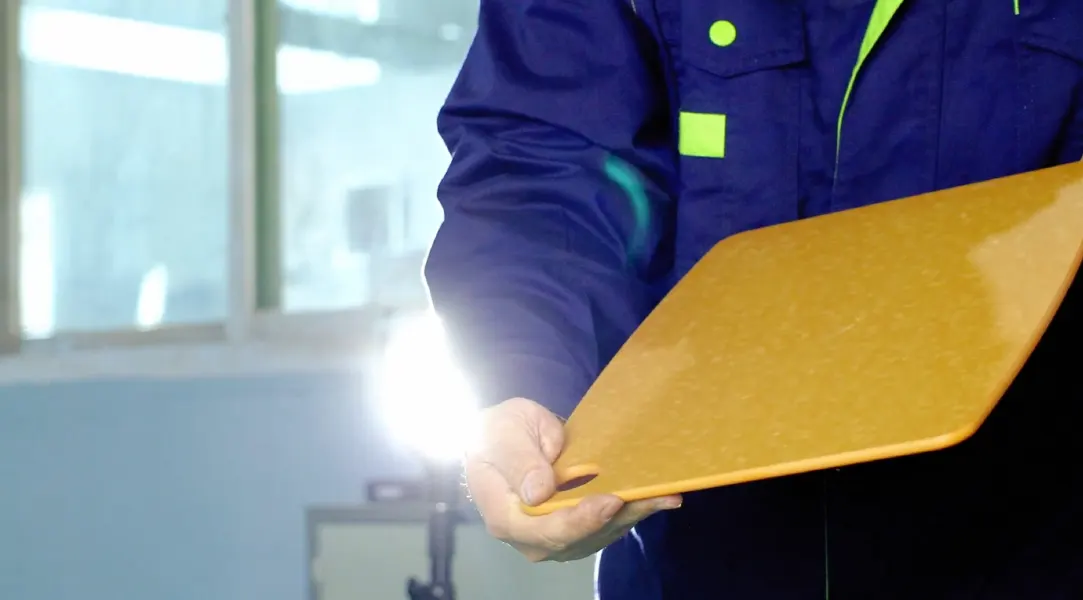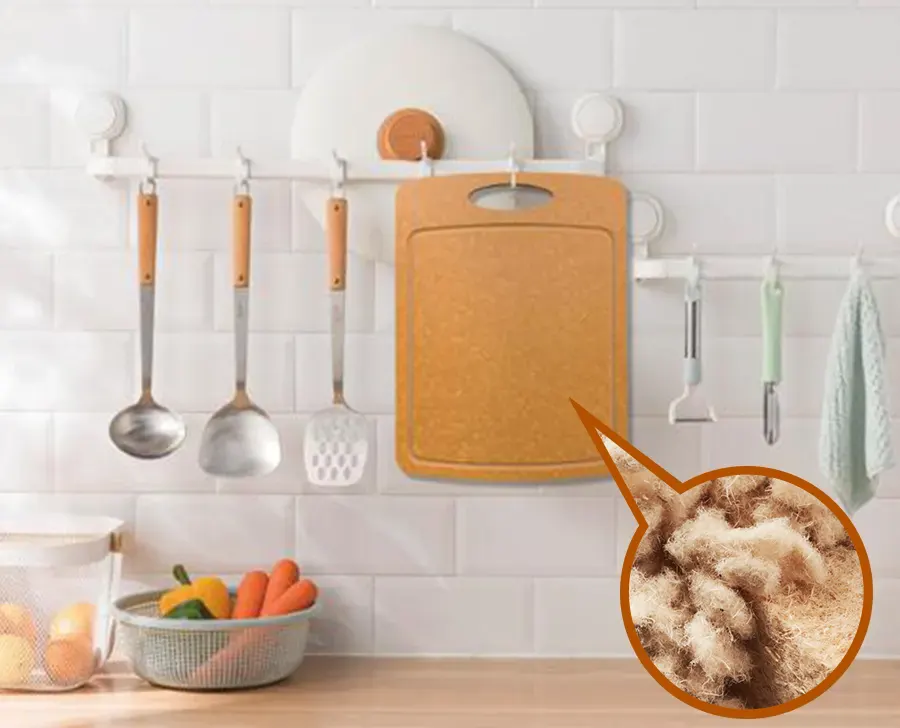Finding the ideal cutting board might seem like a culinary quest, but at Culiex, a cutting board company, we’re here to turn that quest into a fun and exciting journey! Imagine a cutting board that perfectly matches your style and meets all your kitchen needs—sounds great, right? Whether you’re dreaming of unique shapes, vibrant colors, or eco-friendly materials, we have the expertise to bring your vision to life.
Stick with us to explore how Culiex can craft a cutting board that’s not just functional but a true standout in your kitchen. Dive in and see how we can make your kitchen dreams come true!

Cutting Board Material
From FSC-certified Forests
Culiex sources pine wood fiber from FSC-certified forests in the United States, so it also keeps forests in long-term health and provides a renewable resource for future generations.
BPA-free
Our material is NSF cutting board material. Plus, our boards are 100% BPA-free, keeping your kitchen free of harmful chemicals.
Food-grade Resin
Meanwhile, Culiex cutting boards are crafted with food-grade resin that binds the wood fibers together, creating a safe, reliable surface. It not only outperforms traditional wood, stainless steel, and stone options but is also an eco-friendly cut board.
- The surface resists moisture, preventing warping and creating a longer-lasting board.
- It naturally reduces the growth of bacteria, which is essential for safe food preparation.
- The non-porous surface makes cleaning quick and easy, whether you’re working with meats, vegetables, or fruits.
Custom Cut Boards Manufacturing Process
Ever wondered what goes into making safe cutting boards? In a report from the Food Safety and Inspection Service, the U.S. Department of Agriculture, the process of how to make cutting boards is related to the safe degree of the cutting boards. At Culiex, it’s a fascinating manufacturing process that combines precision, skill, and a bit of artistry. Let’s take a closer look at how a cutting board is crafted from start to finish.

Step 1: Preparing the materials
A cutting board is made from an incredibly renewable material. And then we use High-Pressure Laminate (HPL) technology. The material is exposed to bonding layers of pine wood fiber under 1400 Pa of pressure and at temperatures of 180°C to make it dense and lightweight.
Step 2: Cutting and Shaping
Advanced CNC machines precisely cut large pinewood boards into individual cutting board shapes. So, our cutting boards have accurate dimensions and high-quality results.
Step 3: Grooving and Edgework (if needed)
CNC machines add juice grooves (if needed) and finish the edges with R-corners and R-edges according to the design specifications to make smooth and functional edges.
Step 4: Handle Holes (Optional)
For designs with handles, CNC machines drill precise handle holes using specialized tooling, to increase the board’s use.
Step 5: Sanding and polishing
This step removes any rough patches and prepares the board for the next stage. After sanding, polishing brings out the board’s natural beauty and provides a glossy, food-safe finish.
Step 6: Corner Pad Installation (Optional)
For added convenience and protection, our skilled artisans place these pads—available in T-shaped, L-shaped, or rounded designs—using both hand techniques and precision tools. These pads help connect functionality with a touch of elegance.
Step 7: Cleaning
Each board is carefully wiped down or brushed to clear away sawdust and particles. Depending on the material—whether it’s wood, plastic, or bamboo—a mild detergent or specialized cleaning solution might be used to make a thorough clean.
Step 8: Drying
Once the boards are cleaned, they’re set out to dry. Typically, they’re air-dried in a clean, well-ventilated space, often on drying racks that let the air flow around every surface.
This step is really important for getting rid of any leftover moisture, which helps keep mold at bay and ensures the boards stay nice and flat without any warping or cracking.
Step 9: Logo Branding and Design Engraving
We use high-precision laser engraving or CO2 etching machines to add custom unique cutting board designs, logos, or branding to the cutting board. Not only does it add a personal touch, but it also helps the design stand up to everyday use, keeping your branding looking great for a long time.
Step 10: Packaging for Shipment
Packaging and preparation for shipment are crucial for ensuring that cutting boards arrive in good condition. Proper wrapping, labeling, boxing, and palletizing protect the boards from damage and keep everything organized, so they reach you exactly as intended.
- Protective Wrapping: Each cutting board is wrapped in a snug layer of protective material, like shrink wrap, to keep it safe from scratches and damage during its journey.
- Labeling: We add clear labels to each board, featuring essential details like product codes and care instructions, so you have all the information you need right away.
- Boxing & Palletizing: Once wrapped and labeled, the boards are carefully packed into sturdy shipping boxes. These boxes are then neatly stacked and secured on pallets, making the trip to distribution centers or directly to you smooth and secure.

All-round Quality Tests of Cutting Boards
Recent studies from the American Chemical Society (ACS) by the U.S. Congress have shown that cutting boards can release microparticles, particularly when chopping vegetables and other foods, which may pose health risks over time. To mitigate this issue, manufacturers can implement enhanced quality control measures in cutting board production to sell healthy cut boards. Here’s an overview of the process at Culiex:

1. Material Selection and Testing
At Culiex, we focus on using high-quality, non-toxic materials like HDPE and bamboo to create cutting boards. These materials naturally resist breaking down into microparticles, and we put them through careful testing to confirm their durability.
We also run tests that simulate real chopping and cutting, using advanced tools to spot even the smallest particles, helping to keep NSF cutting boards both reliable and safe for daily use.
2. Knife Impact Simulation
At Culiex, our cutting boards go through repeated tests with different types of knives and cutting pressures to mimic everyday use. This helps us spot any weak areas where the material might break down over time. So, we can catch potential issues early and make the boards stay strong, even with heavy use.
3. Thickness Control
At Culiex, we design our cutting boards with just the right thickness to handle all the wear and tear from daily chopping.
Quality control should monitor thickness uniformity across production batches. So, each board is sturdy enough to withstand prolonged use without producing microparticles.
For extra durability, we reinforce the areas of the board that get the most action from knife impacts. This helps reduce material wear and the potential release of microparticles.
4. Environmental Durability Testing
At Culiex, we put our cutting boards to the test with extreme heat, moisture, and temperature changes to check their durability. This helps us see how well they handle tough conditions and avoid releasing microparticles.
We also run multiple dishwasher cycles on the boards. Since dishwashers expose boards to heat and water, we test them thoroughly to confirm they remain intact and don’t release particles. This way, your cutting board will stay strong and reliable, even with regular washing.
Improve Your Custom Cut Board Business with Culiex
Welcome to Culiex, where we blend ‘culinary’ and ‘excellence’ to enhance your cooking and dining experiences. Our expert R&D and design team will work closely with you to craft eco-friendly cutting boards, from initial concept through to final production. Our design cutting board, including CAD design and prototyping, refines your ideas and guarantees a steady supply chain.
At Culiex, we’re committed to creating smooth and satisfying custom cutting board solutions for you. Learn more about how our tailored offerings meet your needs.
1. Product Certifications
Thanks to our excellent production process and quality control, Culiex Sanitaryware proudly holds several prestigious certifications from renowned institutions. So our product meets the highest standards of quality and safety. Our certifications include:
- NSF
- FSC
- FDA
- LFGB
- ISO 9001
- Antibacterial Report
- Anti-Mold Report
2. Custom Cutting Boards
Custom cutting boards offer a unique blend of functionality and personal style, enhancing both your kitchen experience and brand identity. Discover how tailored designs can elevate your culinary space and make a lasting impression.
- Support all kinds of shape envisioning, from classic circles and rectangles to bespoke designs and brand-specific silhouettes.
- 2. Allow different colors and finishes from vibrant Pantone colors, frosted textures, vertical rigato finishes, or metal-like surfaces.
- Wood grains involve various wood grains, such as maple, walnut, teak, and oak, each with authentic textures.
- Stone patterns, including marble, granite, and quartz, for a touch of luxury.
- Cutting board dimensions and thickness, from compact options to large boards with a maximum size of 2.5 meters by 1.4 meters in various thicknesses.
- Thoughtful details and branding, like a logo, a special finish, or a unique feature.
Key Takeaway
Crafting the perfect cutting board involves more than just choosing materials; it’s about blending functionality with style and ensuring every detail meets your needs.
At Culiex, we pride ourselves on turning your cutting-edge ideas into reality. From custom shapes and vibrant colors to eco-friendly materials and meticulous quality control, we handle it all with expertise and care.
Ready to elevate your kitchen with our nsf cutting boards that’s as unique as you are? Contact Culiex today to start your project! Your perfect cutting board is just a consultation away!




















